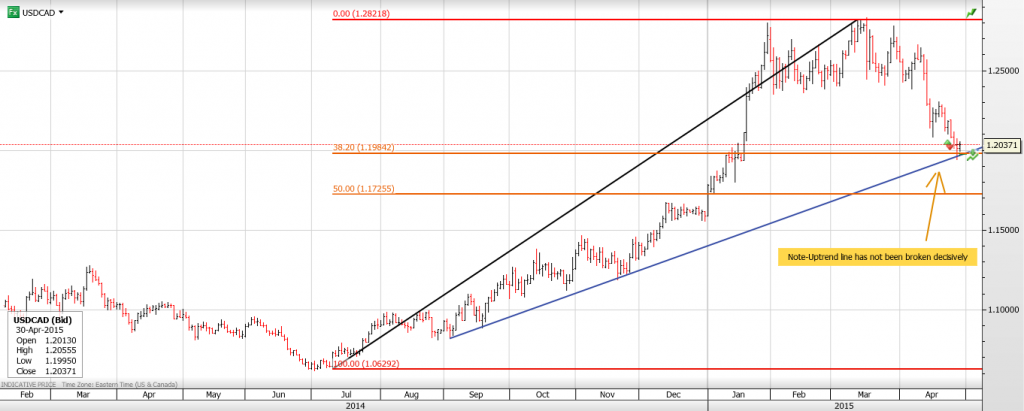Currency
USDCAD Overnight Range 1.1993-1.2070
The Avengers may be called into action today as US dollar selling due to month-end rebalancing flows and renewed risk seeking sentiment may drive the greenback into the ground.
The US dollar never recovered from yesterday’s ugly GDP report and the FOMC statement added to its woes. Many believe that the statement was dovish, although, other than a nod to “transitory” factors it was fairly similar to the March statement.
There was no doubt about the message delivered in the RBNZ statement. Rates could go lower.NZDUSD certainly did, dropping to 0.7580 from 0.7740. The BoJ left policy unchanged.
EURUSD extended yesterday’s gains in a lively European session, aided by good regional data and diminished negativity surrounding the Greece negotiations.
USDCAD traded erratically following this morning’s data dump.Canadian GDP beat expectations and came out unchanged which was good for the Loonie. At the same time, US Jobless Claims and the newly important, employment Cost Index (ECI, both beat expectations, which was good for the US dollar.
USDCAD technical outlook
The intraday technicals are bearish while trading below 1.2060 targeting another test of support in the 1.1940-60 area which if broken, will lead to 1.1725. However, the daily chart, shows that the move below 1.1980-90, may just be a “blip” meaning that the long term uptrend from the July lows is still intact. The result is a lot of churning ahead of the 8:00 am PST month-end fixing time.
Today’s Range 1.1960-1.2060
USDCAD Overnight Range 1.1993-1.2070
US GDP lived up to expectations that it would be weak. It was and the US dollar is getting spanked again. Annualized Q1 GDP was -0.2% vs. forecasts for a gain of 1.1% with part of the weakness being blamed on the strong US dollar. USDCAD was flirting with 1.2055 prior to the number and is currently probing support at 1.2005. EURUSD is testing the 38.2% Fibo retracement of the 2015 range.
The US dollar continued to drift lower overnight on anticipation that the spate of weak US data would result in a weaker than expected GDP report this morning and a downgraded outlook in this afternoons FOMC statement. The news from Greece was a tad more promising as well which may have helped to lift EURUSD above 1.1000.
In Asia, USDJPY defied the dollar weakness trend and climbed to 119.40 from 118.75. However, Aussie and Kiwi didn’t and they both declined. Tonight’s RBNZ rate decision and statement may add to Kiwi’s woes if the Central Bank is a doveish as expected.
USDCAD technical outlook
USDCAD is in a downtrend while trading below 1.2080, supported by the break of support at 1.2050 which is now targeting major support in the 1.1970-90 area. A move below here and USDCAD will drop to 1.1720. A recovery above 1.2050 argues for some 1.1990-1.2080 consolidation
Today’s Range 1.1990-1.2080
USDCAD Overnight Range 1.2052-1.2112
The US dollar is down across the board as traders continue to trim positions ahead of tomorrow’s FOMC statement, exacerbated by the absence of top tier data.
The Asian session was quiet. USDJPY traders ignored Fitch’s downgrade of Japans long term debt while AUDUSD traders ignored a speech by Glenn Stevens. The fact that Mr. Stevens didn’t say anything about monetary policy was probably why. Europe started quietly but EURUSD hasn’t looked back after breaking above 1.0900.
USDCAD is testing support in the 1.2050 area undermined by firm oil prices and dovish expectations for tomorrow’s FOMC statement. The IMM speculative short CAD positions, as reported by the Commitments of Traders Report (CoT) showed a modest decline to $2.7 billion from the previous week’s $3.2 billion. It is not unrealistic to assume that further unwinding is weighing on USDCAD.
Bank of Canada Governor, Stephen Poloz, testifying before the House of Commons Finance Committee this morning, didn’t really deviate from his April 15th Monetary Policy Statement which was a non-event for the currency.
USDCAD technical outlook
USDCAD is probing support at 1.2050 which is guarding the key 1.1980 level reprenting the uptrend from September 2014. A break of this level will extend losses below the 2015 low resulting in a move to 1.1660.
The intraday technicals are bearish while trading below 1.2105 looking for a break of 1.2050 to extend losses to 1.1970-1.2010. A move above 1.2105 will lead back to 1.2140.
Today’s Range 1.2050-1.2110
 It’s been less than a week since the big chiefs of the commodities world met at the FT Commodities Global Summit in Lausanne, Switzerland, situated along the beautiful banks of Lake Geneva, yet already the markets have begun to adjust its collective expectations. So what’s all the fuss about?
It’s been less than a week since the big chiefs of the commodities world met at the FT Commodities Global Summit in Lausanne, Switzerland, situated along the beautiful banks of Lake Geneva, yet already the markets have begun to adjust its collective expectations. So what’s all the fuss about?
Quite simply, all of the commodity moguls, from Gunvor to Glencore to Vitol, all among the largest private companies in the business, have proffered one clear message and it is this: That they, nearly to a one, expect a healthy recovery in commodity prices. With all of the big shots expressing an upbeat view it becomes clear that they are acting on far more information than the rest of us, as one might surely expect, as being in the commodity business allows them ready access to more tangible and viable data. That nearly unanimous upbeat tone should be taken as a rather clear sign that we are about to see a bounce back in commodity prices. Surely, with currencies such as the Aussie, Kiwi, Loonie and the Norwegian Krone, and many more currencies beyond those, being highly sensitive to commodities prices, we are likely to see perhaps a significant impact in the FX arena.
Two Big Predictions
Although the talk at the Commodities Summit was on commodity prices, in general, it was evident that two sectors had drawn more attention than the others. Oil, naturally, because of its importance to the global economy but also Iron Ore, a key ingredient in the making of steel and one of the major commodities exported to China.
Iron Ore prices have now recovered by roughly 15% from their low amid talk of more stimulus and more monetary easing from the Peoples Bank of China in its ongoing efforts to stimulate the economy and allow China’s housing market to recover. With China being the world’s largest Iron Ore consumer and with Chinese traders increasing their stockpiles in anticipation of further gains, many predict that more upside is to come for Iron Ore.
Although most Oil chiefs were upbeat on Oil, one prediction caught investors’ attention; that was the prediction made by Tony Hayward, the former CEO of British Petroleum and the incumbent chairman of Glencore, one of the largest commodity traders in the world. According to Mr. Hayward, Oil prices have bottomed out and Oil will now be heading to $80, undoubtedly a number we haven’t heard for a long while in the context of Oil. The pillar of Hayward’s prediction is the quick reduction in Oil rigs in the US, signaling a sharp reduction in US oil output, with many companies cutting back on future investment in shale oil production. With the US shale Oil boom being a key factor in the steep downfall of Oil prices in the first place it’s understandable why the Oil chief expects a robust return in prices.
Two Laggers to Avoid
In fact, we have talked about the possibility of a rebound in Oil prices for while, with the chances of the Yemen conflict threatening Oil supplies and given the reduction in Oil prices. Now, the key questions are which currencies stands to gain from all of this and how durable will this trend be?
Although most commodity linked currencies will stand to benefit, somehow, it’s fairly obvious which two currencies are the least favored. The first is the Russian Ruble, because despite having an upside potential (in the event Oil prices do recover) the political uncertainty and risk of sanctions make the Ruble a risky long term bet. And the second currency to be less favored in the commodity pack? It is the Canadian Dollar, aka the Loonie. Despite having an upside potential from Oil prices and the surge in commodity prices, in general, there are two factors that hurdle the Loonie’s chance to yield better returns than its peers in the commodity space. The first is the fact that the cost of production per barrel in Canada is one of the highest in the world; hence, Oil prices would have to recover substantially more in order to lift growth in Canada and boost the country’s exports yet the Canadian economy would still lag versus its peers. And the second reason? Canada’s major export destination is none other than the US, and with the US still having record reserves of its own Oil, it’s clear that the liftoff in demand for Canadian Oil in the US will be much slower than it will be for Oil exporters in other areas of the world, i.e. Asia or Europe.
The Outperformers
While there are some potential laggers to this brewing recovery there are some currencies best positioned to outperform. The first would be the Aussie, with its high exposure to China and Asia, in general, and with Iron Ore being one of its major exports to China. The second would be the Norwegian Krone, because while the Krone is oriented towards Oil, unlike the Russian Ruble there is no political uncertainty to weigh on the currency. And unlike Canada, most Norwegian North Sea exports are headed to Europe or Asia. How will this massive trend brew into targets for those currencies? In the next two articles, I intend to crunch the fundamentals of the two and shed light on what I deem as a probable target for the two currencies in the eye of the big commodity rotation.
Look for my post next week.
Best,
Lior Alkalay
INO.com Contributor – Forex
Disclosure: This article is the opinion of the contributor themselves. The above is a matter of opinion provided for general information purposes only and is not intended as investment advice. This contributor is not receiving compensation (other than from INO.com) for their opinion.
USDCAD Overnight Range 1.2132-1.2190
USDCAD drilled through intraday support at 1.2145-50 on a tick higher in WTI oil prices to $57.49/bbl which is a bit perplexing considering the headlines. The oil glut that is straining storage capacity at Cushing, Oklahoma has spread to the Permian Basin in West Texas. In addition, the Saudi deputy oil minister suggested that Saudi Arabia had no intention of curtailing production.
The first day of the last week of April started with a fizzle. New Zealand was closed for Anzac Day and Australia traded like they were, as well. Europe wasn’t much better although EURUSD did decline from the highs. Greece is still the key known unknown. The Finance Minister, Yanis Varoufakis appears to have upset European and IMF lenders resulting in the Greek Prime Minister reshuffling the negotiating team.
USDCAD direction remains tied to WTI oil prices and general US dollar direction. WTI prices have been rising steadily since the middle of March but gains have stalled in the $58.00-$60.00/bbl area. A break of the top will drive USDCAD to test major support in the 1.1990-1.2050 area. Wednesday could be the day, but only if the FOMC statement is considered doveish and indicates that the Fed is on hold for longer than anticipated.
USDCAD technical outlook
The intraday USDCAD technicals are unchanged from yesterday. In fact, the 30 minute chart shown below would show a fairly stable vital signs if it was for a hospital patient. For today, the 1.2180-1.2280 range is likely to remain intact although the short term bias is for a weaker USDCAD.
Today’s Range 1.2110-1.2190
.Chart: USDCAD Daily with support and resistance levels (red lines)


















